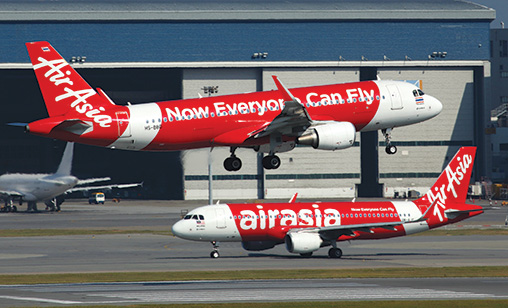News Backgrounder
Downturn sets in as first Asia-Pacific airline orders revised
Production lines at Airbus and Boeing are coming back to life. But slowly, and at the cost of jobs lost forever for hundreds of skilled employees. The aviation behemoths have gone cap in hand to financiers for funding to carry them past the COVID-19 crisis. Associate editor and chief correspondent, Tom Ballantyne, reports.
May 1st 2020
For the world’s two largest aircraft manufacturers, the AirAsia Group decision to cease to accept deliveries of Airbus jets this year is the first but will not be the last domino to fall in forecast aircraft cancellations and deferrals from airline customers across the globe. Read More »
AirAsia Group, an exclusive Airbus customer for 15 years, said on April 29 it would not take any more deliveries of aircraft this year and was “relooking” at its aircraft requirements as a result of COVID-19’s impact on its operations. The LCC group said it would have 242 aircraft at December 31, one less plane in its fleet than it had a year ago. Airbus has sold 660 aircraft to AirAsia Group.
 |
The OEMs are braced for more deferrals and cancellations and know several of them could come from Asia-Pacific LCCs. Last month, the International Air Transport Association (IATA) director general and CEO, Alexandre de Juniac, warned if governments imposed severe social distancing rules on board aircraft post COVID-19, such as empty middle seats on passenger planes, the LCC business model could not survive.
Airbus is not alone in preparing for more aircraft cancellations and deferrals. In recent weeks the rumour mill has been churning at top speed with speculation Cathay Pacific Airways, the Asia-Pacific launch customer for the new 777X family, was about to revise its order for the type to the 787.
Other Asia-Pacific customers for the 777X, with its technologically spectacular folding wings, are All Nippon Airways and Singapore Airlines. Of the big three Gulf carriers with orders for the new wide-body, Emirates has suspended all operations and Etihad Airways is in much the same position but carrying a much larger debt load. The finances of Qatar Airways are opaque, but it has been announced it would commence job adjustments because its global network has evaporated.
At Boeing, the fragility of the Asia-Pacific’s future market, along with the smaller markets of Europe and North America, has forced a reduction in headcount. It said it expected the industry’s recovery from COVID-19 would take years rather than months.
After a four-week shutdown, some 27,000 workers at Boeing factories in Seattle returned to work late last month with their workplaces changed significantly after deep cleansing but with the jobs of many employees under threat as aircraft output is slowed. The company, a storied American success not so long ago, has announced 10%, or up to 16,000, jobs would have to go at the conglomerate because of reduced output.
Boeing Company CEO, David Calhoun, said in the final week of April, after he announced a US$641 million loss for the company in its first fiscal quarter, the job losses would be achieved by voluntary or involuntary lay-offs and natural turnover.
The knife will cut the deepest at Boeing Commercial Airplanes (BCA), at 15% of workers, after the airplane division recorded a 26% drop in revenue for its first fiscal quarter. “The sharp decline in demand, a drop of almost 40% alone in the Asia-Pacific, could not support the present workforce at Renton and Everett [BCA Seattle area factories),” Calhoun said.
 |
“The demand of 2019 will not return for two to three years,” he said. To date, Boeing has offered voluntary lay-offs to 70,000 members of its workforce. “We would ‘need to make deeper cuts in areas exposed to commercial customers, including airline services and corporate services’,” Calhoun said.
BCA’s cutbacks were followed by the announcement by Airbus CEO, Guillaume Faury, which said the company’s survival was at stake as a result of COVID-19. In a letter to his 135,000 employees, Faury warned there could be more job losses to add to announced redundancies and furloughs of staff. Airbus reported a loss of US$515 million for its first fiscal quarter of the year. It cancelled its dividend and also its outlook for 2020.
The one third cut in output could drop again depending on circumstances and is “being kept under review”, Faury said. Airbus narrow-body output is now 40 a month and wide-body jet production has been trimmed compared with past rates.
Airbus has furloughed more than 3,000 workers in France and another 3,200 in Wales, its UK production centre for its aircraft wings.
Engine manufacturers have had to follow the lead of commercial airplane manufacturers as the market for their civil aircraft engines has dried up. Later this month, Rolls-Royce is expected to announce its biggest single reduction in staff for 30 years, with a restructuring that will shed the jobs of 15% of its 52,000 member workforce.
Rolls-Royce manufactures engines for the 787 and the A321, A350 and A330 Airbus aircraft types.
Already about 25% of the engine OEM’s civil aerospace workforce has been furloughed and job losses for the division are expected to go beyond the UK to Germany and the OEM’s regional hub in Singapore.
Rival engine OEM, U.S.-headquartered GE Aviation, removed 2,600 staff from its payroll in March and at the turn of this month said it intended to eliminate another 10,000 aerospace jobs because of the negative impact of the coronavirus on its order book.
But unlike Airbus, Boeing’s troubles are not only about the impact of COVID-19 on its business. It has the MAX issue to overcome.
Approximately 37%, or 136 aircraft, of the grounded MAX 737 fleet is in the Asia-Pacific. Top of the list is China, with 97 737MAXs, followed a long way down the line to India with 13. Asia-Pacific aviation is forecast to be hardest hit by the coronavirus.
The MAX’s grounding in March last year, following two fatal crashes that took 346 lives, is costing the company billions of dollars in compensation claims, revised rates for purchase agreements, order deferrals and cancellations and the long, costly process of the narrow-body’s re-certification.
At Airbus, employees were told a return to full operations was not feasible in the short term because of parts shortages and the inability of struggling airlines to take delivery of new aircraft.
In reality, the news worsens, and for once, there is little disagreement between the U.S. and European rivals about their business prospects. “The aviation industry will take years to return to the levels of traffic we saw just a few months ago,” said Calhoun.
Faury said last month: “We are in the gravest crisis the aerospace industry has ever known. We need to work as an industry to restore passenger confidence in air travel as we learn to coexist with this pandemic.”
The reality is commercial jets will not be rolling off production lines at the rates seen before the COVID-19 crisis. Struggling airlines will have no appetite for new capacity for some time to come, given the International Air Transport Association estimated airline revenues would drop by $314 billion this year. A separate forecast, released in April by the International Civil Aviation Organization, puts the losses at a slightly lower but just as disastrous figure of $254 billion.
GlobalData aerospace and defense analyst, Nicolas Jouan, said the regions to be hardest hit by the pandemic will be the Asia-Pacific, Europe and North America, the dominant engines of air travel growth. “In other words, air travel is set to disappear almost entirely in 2020. This projection will likely result in successive cancellations of orders from clients wary of COVID-19’s long-term impact,” he said.
“However, it would be wrong to reduce everything to COVID-19. Some more fundamental issues of the commercial aviation industry also are at play. Boeing has made unfortunate headlines with massive cancelations of 737 orders this year.
“While some cancellations have been connected to COVID-19 and the slowdown of activity, for example Avolon’s 75 737MAX cancellations at the beginning of April, others from Air Lease Corporation and Air Canada earlier this year could be wider scale strategic decisions to slim order books in front of a pre-COVID-19 slowdown in the Asian market.”
GlobalData added the 737 MAX grounding “has made the type a privileged target for cancellations when things get rough for airlines”.
“Airbus seems to have decided to employ any means necessary to mitigate the catastrophic impact of COVID-19 on commercial aviation. Jetliners represent 70% of Airbus revenues according to 2019 figures,” Jouan said. “Reducing production, even temporarily, of the best-selling A320, A330 and A350 families by 30% to 40%, is virtually renouncing at least a quarter of its usual cash flow for the time being.”
“The single-aisle market is confronted by pressures on margins. Considering defense and space represent less than 20% of Airbus’ revenues, against 34% for Boeing, sources of cash flow are starting to look meagre for the [Toulouse] plane maker.”
In essence, as airlines are forecast to burn through some $61 billion in cash in the second quarter alone, with more to come in the third quarter, they are holding off taking deliveries of new aircraft and pausing capital investments like planes.